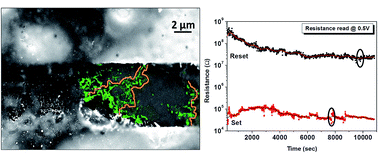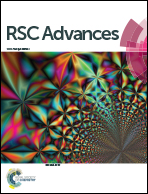Ionic liquid-enhanced soft resistive switching devices†
Abstract
Resistive switching phenomena are of paramount importance in the area of memory devices. In the present study, we have fabricated a simple resistive switching device using a solution processable nanocomposite based on silver nitrate and poly(vinylidene fluoride-hexafluoropropylene). The change in resistance is ascribed to an initial ionic conduction, followed by a non-continuous field induced filament formation. The switching device fabricated with the above-mentioned active matrix displayed a volatile switching behavior. The addition of room temperature ionic liquid plays a fundamental role in triggering permanent memory and reducing the set voltage range up to ten-fold. The change in switching behavior with respect to the applied voltage bias and compliance level set during electrical characterization was studied thoroughly. The present work also gives a glimpse into the importance of device architecture on resistive switching phenomena.



 Please wait while we load your content...
Please wait while we load your content...